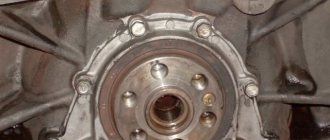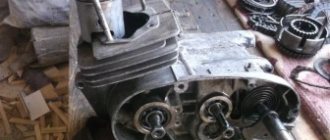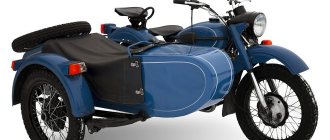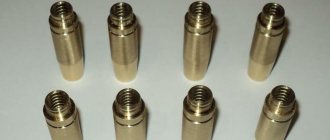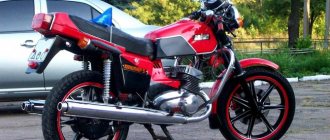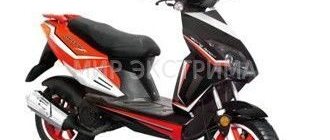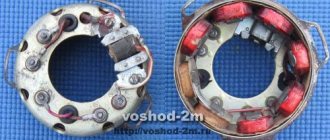In 1983, the Kavrovsky plant launched the modernized Voskhod 3M motorcycle. The purpose of the modernization was to improve the operational and technical characteristics of the Voskhod motorcycle. The platform for creating the motorcycle was the Voskhod 2M model. Since the early 90s, serial production of the Voskhod 3M 01 modification began. But still, many owners of this device are not satisfied with the appearance. Therefore, in this article we will talk about tuning sunrise 3m.
Engine tuning
The Voskhod 3m tuning engine which we will consider is a simple, 2-stroke engine with one cylinder. This engine is considered its own development, but has many similarities with motorcycles of Japanese origin. Experienced tuners assure that with the right approach, you can extract almost twice as much power from this engine as it comes from the factory. But you can’t do it with just one stroke; you need a careful approach and studying mountains of specialized literature. Let's look at what we can change to ride the Sunrise motorcycle faster:
Motorcycle improvement
Boosting the engine The Voskhod motorcycle has not been produced for a long time, but it does not lose popularity in our time. This is due to the low cost of Soviet equipment. But the old technology has several disadvantages: low power indicators, outdated design. Therefore, in order to get a high-speed and modern means of transportation from an old motorcycle, drivers carry out tuning of the sunrise 3m with their own hands.
Appearance tuning
As for appearance, the list of improvements can be divided into three groups:
Today, the most popular is restoring the factory appearance of a sunrise motorcycle. As we have already said, retro motorcycles, which have become fashionable, are very popular among both young people and older people. Moreover, literally every element is subject to recovery and restoration. The motorcycle is disassembled down to the bolts and then reassembled.
And in this article you can learn how to make an ATV in your garage. Manufacturing technology, selection of spare parts and many secrets of construction.
Those who chose this vehicle not as a tribute to fashion, but as a practical motorcycle, prefer to modify the appearance. The improvements include those elements that this motorcycle is so lacking: a dashboard, roll bars, panniers, high-quality lighting.
Last but not least is the radical tuning of the appearance of the Voskhod motorcycle. Here we will place improvements that affected major components and frame geometry. Some craftsmen manage to convert this road motorcycle into a full-fledged cross-country or enduro motorcycle. A new tank is installed, the tail of the motorcycle is lifted up, and sports shock absorbers are replaced. The most experienced Kulibins integrate a mono shock absorber from Japanese motorcycles into the rear suspension. On the other hand, modifications to the chopper style. Here, a long front fork and a thicker rear wheel invariably appear. Together with the high handlebars and forward footrests, the landing turns into a lordly one. All that remains is to get a huge seat and you can absorb kilometers of roads.
Voskhod (motorcycle) - WiKi
"Sunrise"
"Voskhod" (1965-1971) had a single-cylinder two-stroke engine, a two-channel loop blower according to Schnürle's patent, and a four-speed gearbox. Unlike its predecessor (motorcycle K-175V), engine power has been increased to 10 hp. (at 5,200—5,400 rpm), torque up to 14 Nm (at 5,100 rpm), contact ignition, G-411 generator, the shape of the gas tank was changed, a trunk and knee pads appeared[1]. Maximum speed - 95 km/h[2], dry weight - 110 kg.
"Voskhod-2"
Voskhod-2 (1972-1977) differed from its predecessor in technical solutions aimed at improving performance, reliability and appearance. In 1976 it was modernized. Externally, it differed from its predecessor in round direction indicator lights (previously they were rectangular), a rear light, and new-shaped mufflers. New light signaling devices, an electronic non-contact ignition system with a G-427 generator, and a new muffler were used. The strength of the teeth in the gearbox has been increased, and more advanced drive discs have been used in the clutch, which has increased the clutch safety factor to 1.47[1]. Engine power was 10.5 hp. (at 5,400 rpm), torque 15 Nm (at 5,200 rpm). Maximum speed - 95 km/h, dry weight - 112 kg.
"Voskhod-2M"
Voskhod-2M (1977-1979) had increased engine power to 14 hp. at 5,500—5,800 rpm (maintaining the same working volume of 173.7 cm3) and maximum torque up to 1.6 kgf m (16 N m) at 5600 rpm due to changing the configuration of the channels in the crankcase and cylinder and a new cylinder head (compression ratio increased to 9.2, no decompressor, central location of the spark plug in the combustion chamber). The upgraded engine was designed for high-octane gasoline AI-93, but could also run on A-76[1]. The front fork has been changed - the diameter of the pipes has been increased and the shock absorbers have been improved, the fork travel has increased by 20 mm and amounted to 160 mm. Maximum speed - 105 km/h, dry weight - 121 kg.
"Voskhod-3"
“Voskhod-3” (1979-1983) differed from its predecessor in a different gas tank (holds 2 liters more fuel), an intake system, adjustable rear shock absorbers and increased energy capacity (located at an angle of 12° to the vertical, providing a wheel travel of 105 mm), the springs of the rear shock absorbers became open. Modernized brakes were used (the diameter of the brake drums was increased from 125 to 160 mm), wheels with stronger spokes, a G-427 generator (rated voltage 7 V), a rear gear driven sprocket damper was introduced, the saddle was improved, a lighter front wheel guard was installed, reel throttle handle. Maximum speed - 105 km/h, dry weight - 125 kg.
"Voskhod-3M"
Voskhod-3M (1983-1993)[3] had cylinder fins with an increased cooling surface. Some engines were equipped with Czechoslovak-made carburetors. 12-volt electrical equipment was installed, an FG-137B headlight with a “European beam” diffuser, and a new rear light with side reflectors. Above the headlight there is a block of control devices made of plastic: ignition switch, speedometer, indicator lamps for direction indicators, low and high beams. In addition, an anti-theft lock was installed. The front shock absorbers received corrugated rubber covers. A brake lining wear indicator was installed on both wheels. The motorcycle received a new profiled front wheel guard, a kickstarter lever with a folding pedal instead of a solid one, folding driver's footrests, and two rear-view mirrors. The factory warranty for the model was 20 months[4].
Maximum speed - 105 km/h[1], dry weight - 122 kg. On the basis of this model, the production of the Voskhod-3M Krokha tricycle was organized; the body had a load capacity of 200 kg. Speed 80 km/h, rear gearbox borrowed from the Ant scooter.
"Voskhod-3M Lux"
"Voskhod-3M Lux" was distinguished by a higher quality paint and varnish and galvanic coating. Instead of rubber covers, rubber boots were put on the front fork seal housings, and the stationary pipe was covered with chrome. It was planned to install movable fork pipes made of aluminum alloy, and it was also planned to install wheels made of aluminum alloy; equipment for these parts was specially ordered in Kiev. Road tests were carried out on motorcycles with wheels entirely made of aluminum alloy and wheels of a more complex design, consisting of a metal rim connected by screws through polyurethane spacers with a “star-shaped” aluminum hub. But the quality of casting parts was low, and it was decided to abandon alloy wheels. On the nameplate, after the inscription “VOSKHOD-3M”, there was the letter “L”. Dacron based stickers were used. The motorcycle was equipped with roll bars, a combined fairing and a wire trunk. The seat had a more comfortable shape due to the use of a new latex filler and a new cover. The middle and lower cladding closures were installed in metal. On the left side of the motorcycle there was a handle in the form of a bracket, using which it was convenient to install the motorcycle on the central stand. The motorcycle was equipped only with a center stand. Produced in a small series in 1984-1986, the number of motorcycles assembled is unknown. Engine - 173.7 cm3, power - 14.0 hp. (at 5600 rpm), 4 gears; weight - 123 kg; gas tank volume - 14 l; wheels - 3.25-16″ / 3.25-16″; Max. speed - 115 km/h[5].
"Voskhod-3M-Tourist"
“Voskhod-3M-Tourist” (1985—?) received a new sports-type steering wheel with a jumper, safety arches, two rear-view mirrors, tourist equipment (rear trunk with side sections, side bags made of artificial leather, a tablet bag for fuel tank). The motorcycle has new inscriptions on the tank and the lids of the tool boxes, and the stickers are made of lavsan film[6]. Maximum speed - 105 km/h, dry weight - 125 kg.
"Voskhod-3M-01"
Motorcycle “Owl”
“Voskhod-3M-01” (1989—?). A new reed valve engine was installed on the old chassis. The modernized engine featured a cylinder with a five-channel scavenging and one exhaust port (the Voskhod-3M model has two channels). The cylinder diameter was increased from 61 mm to 62 mm, and the piston skirt was also increased. The engine crankcase began to have a low neck, and the bypass channels were moved to the cylinder body. The motor transmission has been strengthened and its chain has become wider. A reed valve at the inlet reduced fuel consumption to 4.2 l/100 km and also reduced exhaust emissions. Power increased to 15 hp. at 6,000 rpm, maximum torque up to 17 Nm at 5,500 rpm. The engine has one muffler. The motorcycle's handlebars became wider and received a crossbar. The chain was lengthened by 2 links[7].
Subsequent upgrades of the Voskhod series received the new names “Owl” and “Courier”.
ru-wiki.org
Complete disassembly of the Voskhod motorcycle engine - we do it ourselves
It is not clear why Voskhods have gained fame as unreliable and capricious motorcycles. You might think that Jupiter or Ant is much better than Sunrise. However, this opinion still exists in the motorcycle community. Well, okay, if there is such an opinion, then so be it.
Someone had already “overhauled” the engine before us, then we drove it a little, removed the cylinder for boring and rolled it into the garage for the winter. While the motorcycle was standing in the barn, water began to flow into the engine... And when spring came to the yard, the owner wanted some drive... Well, let's give him some drive.
Replacing clutch discs
Motorcycles Voskhod, Voshod-2(M) and Voshod-3(M) were produced from 1965 to 1993 and were distinguished by excellent technical and operational qualities for their time. All of them were equipped with 173 cc two-stroke engines, which had one air-cooled cylinder and carburetor power. This allowed the motorcycle, depending on the modification, to reach a maximum speed of 90-105 km/h with a fuel consumption of no more than 4.5-5.5 liters per 100 km. In general, Voskhod has established itself as a reliable and durable vehicle, capable of operating for many years with proper maintenance. However, time takes its toll, and the need to repair Soviet equipment arises more and more often. Let's try to figure out what features are characteristic of restoring the main components and assemblies in the process of repairing a Voskhod motorcycle.
What kind of breakdowns can occur in Voskhod, Minsk, Sova bikes?
And the only sure way to keep these “veterans” of the motorcycle industry on track is to timely diagnose and eliminate breakdowns, and carry out repair work using high-quality spare parts. We advise you to take a closer look at the following weak points of these motorcycles:
Although the basic equipment of the motorcycle is quite laconic, it is not without its shortcomings.
· rather weak engine, inability to accelerate over 100 km/h;
· possible slippage due to ill-conceived design of the clutch assembly;
crankshaft deflection due to poor placement of bearings;
· rigidity of factory shock absorbers;
· not too powerful brakes.
Engine
The “heart” of a motorcycle, even with the most careful use, gradually wears out - this is facilitated by the abundance of heterogeneous mechanical loads in the cylinder-piston group and other moving parts, temperature effects on the metal, the chemical composition of the working mixture and exhaust gases. DIY motorcycle repair Voskhod most often includes the following engine work:
Engine repair, like the repair of other units, must be preceded by a comprehensive diagnosis of its technical condition, which includes an analysis of operational parameters (approximate indicators of developed power and speed, fuel consumption, sound of operation, color and character of the exhaust). If necessary, diagnostics are performed on the bench, and specialized instrumentation is used.
It is important to navigate the structure of a two-stroke internal combustion engine of a motorcycle and understand how each specific type of repair is performed. So, when replacing piston rings, you can do without removing the engine. It is enough to unscrew the stud nuts, remove the cylinder cover and, opening access to the piston, bring the piston to top dead center. Then the worn rings are removed and new ones are installed. The engine is assembled, not forgetting to replace the gasket. This completes the repair.
Photo report: Installing a piston on a motorcycle “Izh”, “Ant”, “Voskhod”
In matters of choosing one or another engine repair strategy. When it comes to repairing Soviet two-stroke motorcycles, it is advisable to adhere to a strategy that involves the complete restoration of original parts. And if this is not possible, with a creaky heart, you are forced to buy counterfeit goods or look for a used option.
There is little point in dwelling on the boring process in detail. Boring involves restoring the geometry of the cylinder by increasing its diameter. You don't need to know more about boring. There are turners, let them bother with these subtleties
Ignition and carburetor
It is these two components that, as a rule, determine the stability of the engine. Often, interruptions in the crankshaft rotation speed, loss of traction, and difficulties starting the engine are associated precisely with their malfunctions. Repairing the ignition and carburetor usually comes down to adjusting them. Setting the ignition includes setting the gap between the coil core and the sensor magnet within 0.295...0.305 mm. The piston ignition timing should be 3.5-5 mm to top dead center. Adjusting the carburetor is somewhat more difficult. If you are repairing a Voskhod-3M motorcycle, then you will have to deal with the K65V carburetor, and the main tools will be the quality and quantity screws included in its design. Using the first, you can lean or enrich the mixture - change the proportion of fuel and air entering the cylinder. The second determines its volume per working cycle. With the standard setting, the quality screw is screwed in completely and then unscrewed half a turn. Then the rotation of the quantity screw achieves the minimum stable speed and the quality of the mixture is re-adjusted. Finding the optimal adjustment balance is a search for maximum traction and stability with minimum fuel consumption.
Improved ride quality
Along with the growth of power comes the need for its full implementation. To do this, you need to carefully consider the current state of the chassis system and, if necessary, adjust or even replace some components.
- Rear shock absorbers. The standard suspension is quite soft, so if in your improvements you are aiming to increase the acceleration of the Voskhod motorcycle, then it is worth replacing the original shock absorbers with adjustable ones. Hard adjustment corresponds to improved acceleration, and on the contrary, soft adjustment slightly slows down acceleration.
- Front fork. First, you should check the condition of the fork as a whole; to do this, you need to check its maximum travel in both directions. For this model, the difference between the upper and lower indicators should be within 20 - 40 mm. Less - the fork is too tight, more - the fork is too soft. If configured correctly, replacement or upgrading of this unit is not necessary.
- Tires. A very important point is the type of tires. If you travel in rural areas or are a frequent visitor to off-road conditions, then it is better to choose tires with a developed pattern. To move along the highway you need special road tires, which perfectly hold the motorcycle on a straight line and in difficult turns.
Preparation
Russian is Russian, so until we process all the parts properly with a file before installation, nothing will work out...
Insert the cylinder rings and use a feeler gauge to measure the gap in the lock.
To reduce engine noise and speed up the ring grinding process, remove small chamfers on their working edges (preferably)
To improve lubrication of the piston pin, use a 5-6 mm drill to drill through holes in the piston bosses (optional)
We remove flashes and deposits of metal in the cylinder windows and round the edges along which the rings go
Tuning options
Refinement of the design involves internal or external tuning. During internal modifications, the engine is rebuilt, driving parameters, suspension, and brakes are optimized. When external modifications are made, the motor vehicle is given a sporty style or it is converted into a chopper.
Features of internal tuning
Owners often rework the Voskhod-3M engine. To increase engine thrust, the factory paper air filter is replaced with foam filter elements. This helps reduce air exhaust friction. Then the jets and diffusers are polished using an abrasive material, the diameter of which affects the volume of fuel entering the engine.
To improve the fuel exhaust system, a new modernized carburetor is installed. From the existing pipe, take flanges for mounting on the cylinders, grind out aluminum bushings, and cut off the flange from the exhaust pipe. In an old carburetor, take a second flange. Using cold welding, the parts are connected.
The design is adjusted until it fits perfectly into the exhaust channels. Internal gaps are filled using epoxy glue.
Often rear adjustable shock absorbers are installed and sports tires are installed. When performing such tuning, the motorcycle becomes more aggressive and sporty.
Performing external tuning
In a sporty style
With a low seating position and a high front fork, there is a desire to modify the motorcycle in accordance with the sporty style. To do this, raise the rear shock absorbers and replace the exhaust pipe elbow. This way the exhaust pipe is level with the rear axle. Exhaust pipes with a larger diameter will improve the design and increase the traction of the bike.
External modifications can include painting, chrome plating, installation of nickel-plated arches instead of the old factory protection, installation of large rear-view mirrors, stepped seats and wheel tuning.
At the end of the tuning, a sports fairing is installed.
Chopper
When performing tuning for a chopper, shortened rear shock absorbers are cut off or purchased. Thanks to this replacement, the rear of the motorcycle will be lowered by several centimeters. The rear fork and wheel are replaced with wider ones. The angle of inclination of the front fork axis is replaced, and the cylinder covers are equipped with chrome plated cups. The same style is followed when tuning the headlights, rear lights, and dashboard.
Tuning for Cafe-bike
With such a modification, to reduce costs, they weld the rear part of the frame with their own hands, shorten the fork, trim and adjust other parts. For the steering wheel and seat, your own strength may also be sufficient. A headlight with a brake light is installed from trucks.
Most owners can carry out tuning on their own using only purchased parts due to the simplicity of the designs and the low cost of spare parts.
Voskhod-1 | Moto-Kovrov
"SUNRISE"
Carrying out the party's directives to introduce the achievements of scientific and technological progress, Kovrov motorcycle builders began to create a more modern machine. The designers sought to bring the model under development closer to the best foreign models. And they achieved it.
On October 12, 1964, the Voskhod spacecraft was launched - the world's first multi-seat vehicle - with a crew consisting of cosmonaut-pilot Komarov, designer Feoktistov and doctor Egorov. The propaganda effect of the new achievement of Soviet science and technology was colossal. And employees of the SKB motorcycle manufacturing plant named after V.A. Kovrov. Degtyarev, who were just then developing a new motorcycle model, did not puzzle over what to call it. Of course, "Sunrise"!
The Voskhod motorcycle model was designed in 1964, and began its journey to the consumer with the release of a pilot batch of 298 pieces at the end of 1965. Factory designer Leonid Avgustovich Zveryuga managed to create a memorable, integral look - without resorting to copying foreign designs. Before this, “Voskhod-1” (as the motorcycle was listed in the technical documentation) was tested in competitions with foreign motorcycles.
The 1965 motor rally was held in Germany in Nuremberg on the Nurburgring track, where the riders arrived without breakdowns or delays. Here the factory motorcyclists achieved success, winning the FIM prize - “Horse in the Race”.
Then a performance in 1966 in France.
Later, performing at the 1968 motor rally in Italy, the Kovrov team took an honorable second place and received the Monaco Cup prize.
According to the competition conditions, the team covered the path from Kovrov to Perugia on motorcycles.
A motorbike rally was also organized to places of military glory along the route Kovrov - Moscow - Minsk - Brest - Kyiv - Kovrov.
The motorcycle under the new trademark “Voskhod” was based on events such as; improving the appearance, increasing the performance of the motorcycle, increasing reliability and durability, eliminating defects that occurred on the previous model.
The team of workers and engineers was awarded a gold medal by the VDNH exhibition committee for their creative work.
Engine
The engine retained the basic design - single-cylinder, two-stroke, short-stroke (61.75x58.0 mm = 173.7 cm³), but thanks to an increase in the compression ratio, a change in the outlet angles of the purge channels and a decrease in the intake tract resistance, the maximum power increased from 9.5 to 10 liters .With. at 5300 rpm. At the same time, the maximum speed of the motorcycle increased from 85 to 90 km/h, and fuel consumption decreased by 0.1 liters per 100 km. The engine of the Voskhod motorcycle was equipped with a modernized gear shift mechanism, which made it possible to reliably record the engagement of the corresponding gear. For the gearbox, special mounting dimensions for the gears were calculated using a compensation washer installed at the left input shaft bearing, instead of the one installed on the previous model at the main gear. The rubber covers for the reverse gear had special flaps that closed two technological holes in the right half of the crankcase, the third technological hole was closed with a rubber plug. These measures prevented the access of dust, dirt and water to the reverse gear chain and thereby increased its service life. The new design of the breather became sealed - in it the crankcase cavity was connected through a PVC tube to the receiver of the suction noise muffler. This design prevented dust, water and dirt from entering the crankcase.
The air purification system has been changed. The receiver, which simultaneously serves as an intake noise silencer, was connected by two rubber pipes to the air filter housing, and not one as was the case on the previous model. The filter element, instead of a metal mesh, was made of elastic polyurethane foam, resulting in improved air purification. The air filter consisted of a housing and a cover, which were made of nylon, as well as a metal grille and a filter element impregnated with motor oil mixed with gasoline.
The carburetor cover was shaped differently from the previous model.
Electrical equipment
On the motorcycle, instead of the G-401 generator, a new G-411 generator was installed, the power of which was 10 watts higher. The G-411 generator had a new capacitor with a capacity of 0.25 microfarads. This generator ensured uninterrupted sparking in the range of 350-6000 rpm, significantly improved road illumination and increased the lighting characteristics of signal devices. There was a special output from the generator stator for the brake light.
A special B-300 ignition coil was designed for the new generator.
Instead of the FG-38V1 headlight, a new FG-138 headlight was installed.
The headlight rim received a visor, a new diffuser design and a headlight lamp with filaments of the same power were also used. These changes reduced the possibility of burnout of headlights and taillights and ensured good asymmetric illumination of the road.
The FP-66 rear light of the previous design was obsolete and did not meet the aesthetic requirements of that time. Therefore, a new design taillight with a plastic housing was installed on the Voskhod. It had two lamps, one of which worked as a signal and illuminated the license plate, and the second was intended for the brake light. In the right tool box, two M5 screws were used to secure the brake light switch, driven by a spring from the foot brake pedal.
The rear light wire had a plug connector, instead of being connected with a screw and nut through terminals.
To improve appearance, the switch base, lever and signal button were made of cream-colored plastic, and the metal body was painted with ivory enamel.
Crew part
On the previous model, the side closures had a rubber wrapping cord secured with nine galvanized rings; later, a wide ivory-colored polyvinyl chloride cord was used.
The modified design of the closures allowed the use of a new profile of ivory-colored PVC wrapping cord. The appearance of the motorcycle has improved significantly.
The newly designed folding seat provided easy access to the air filter and pump, mounted in brackets on the seat frame.
The new seat cushion has increased its elastic properties and improved ride comfort for both driver and passenger.
The shape of the new two-tone seat cover (red top, black bottom) has significantly improved the appearance of the motorcycle in terms of aesthetics. A new ivory colored PVC passenger handle was attached to the seat using two M6 screws. The designers also strengthened the frame structure, increasing the diameter of the front and top tubes from 32 to 34 mm.
The main changes in the design of the front fork were that a nylon reflector was installed in the springs, which prevented oil from leaking out when the fork was activated through the breather holes in the plugs.
The new Voskhod fuel tank received nigrips (knee pads) of a new shape, an ivory-colored polyvinyl chloride edging covering the weld seam, a new logo in the form of a horizontal arrow made of white plastic and the inscription “Voskhod” made of brown plastic.
All these measures significantly improved the appearance and fully met the aesthetic requirements of that time. The fuel tank plug was made of ivory-colored plastic.
Using two racks fixed in the area of the headlight and the upper yoke, and four special brackets, a windshield made of organic glass was installed on the motorcycle.
Taking into account numerous requests from consumers, a small trunk with an estimated load of 15-18 kg was installed on the new model.
The steering wheel brackets had a different appearance.
The control knobs were installed with a new design and were made of elastic light rubber that did not stain your hands.
The “lamb” type damper head and the enrichment shifter were made of a more durable MCH material, ivory-colored.
To prevent dirt from getting on the driver's clothes, the motorcycle was equipped with knee guards made of black or white nylon.
The front wheel hub cap has been redesigned for easier polishing.
The design of the base of the front wheel brake pads was changed, for the convenience of processing the outer surface of the base; the support bracket for the front brake cable sheath was removable and secured with an M6 bolt.
The short brackets for fastening the rear shield on the yoke handle were replaced with elongated chrome ones, which, in addition to improving the appearance, significantly reduced the vibration of the rear shield and thereby eliminated the possibility of transverse cracks. The yoke handle on the new model was missing.
The round driver and passenger footpegs have been changed to more modern square ones.
Instead of painting, the wheel hubs, front and rear brake bases were polished and glossed.
Instead of galvanizing, the following were coated with chrome: front and rear brake levers, foot brake pedal, chain tensioners, brackets and control levers for the clutch, decompressor and front brake, front fork oil seal housings, throttle handle housing, throttle handle mushroom, as well as a number of fastening parts: bolts, screws, nuts and washers.
For the first time on the Voskhod motorcycle, a rear view mirror was installed on the left handlebar.
The bushings of the front fork casing, made of TsAM alloy, were replaced with nylon ones, which eliminated the unpleasant “rattling” of the casings.
All specific parts and assemblies: fuel tank, front and rear wheel guards, closures (side and top), tool box covers, front fork casing, upper and lower traverses - before coating were thoroughly cleaned to a glossy surface according to standards, then phosphated, primed and painted with synthetic enamels, followed by polishing and glossing to a mirror surface. The headlight was supplied by a related company in black. Motorcycles were painted black and blue.
In 1967, to celebrate the 50th anniversary of the Great October Revolution, a limited batch of motorcycles was assembled.
On the front fender of these motorcycles there was an aluminum flag with the image of a “hammer and sickle” and the inscription “50 years” on a red background.
This batch of motorcycles was painted red. Knee pads were installed in cream-colored metal.
The number of motorcycles assembled is unknown.
In 1969, another limited edition (anniversary) was released to celebrate the 100th anniversary of the birth of V.I. Lenin.
On the front fender of these motorcycles there was an aluminum flag with the inscription “1870-1970 Jubilee” on a red background.
The anniversary party was also painted red. Metal knee pads were painted ivory.
The number of motorcycles assembled is unknown.
Both batches of motorcycles were produced of excellent quality in export versions.
From 1965 to 1972 1,039,484 Voskhod motorcycles were assembled.
Motorcycles collected for the 50th anniversary of the October Revolution and the 100th anniversary of Lenin can be viewed in the private museum of Nikolai Tubaev.
moto-kovrov.ru
Transmission
During transmission repairs, the following work may be required:
Most of them require high qualifications and are difficult to do at home. The exception is the repair and replacement of drive mechanisms. So, sometimes there is a need to restore the splines for the gearbox foot, replace the clutch cable or its jacket, or adjust the clutch. These works are carried out without disassembling the crankcase.
Repair and operation of the Voskhod motorcycle are closely interconnected due to the age of the model. However, with the proper approach to organizing and carrying out repairs, the motorcycle will remain your faithful friend and assistant for a long time.
Source
